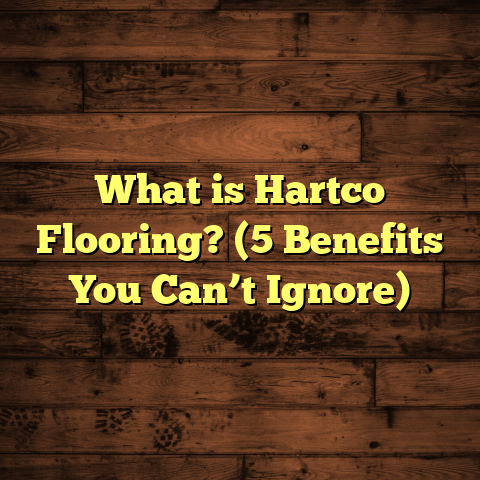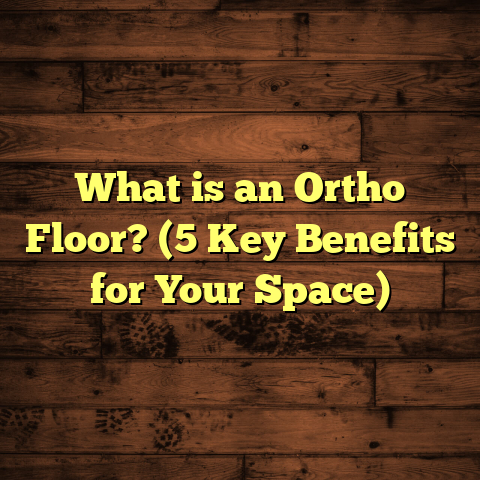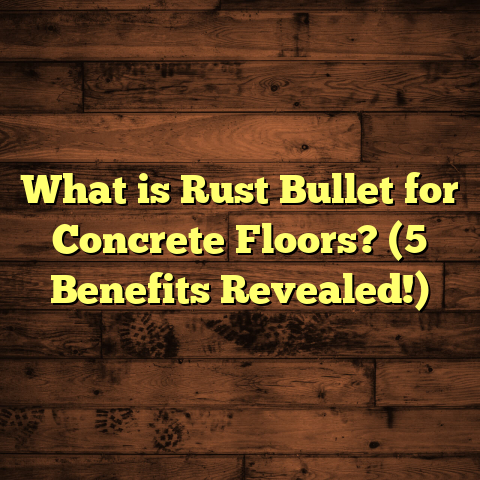What is a Wood Floor Worth? (5 Key Factors Affecting Value)
Have you ever stopped to think about what makes a wood floor truly valuable? Maybe you’re considering installing wood flooring or selling a home, and you want to know how much that beautiful surface is actually worth. It’s a question that’s more complex than it seems. I’ve been working with wood floors for years—installing them, restoring them, and advising homeowners—and I’ve learned that the value of wood flooring isn’t just about the price of the wood itself. It’s affected by a mix of factors that together set the floor’s true worth.
What exactly goes into determining the value of a wood floor? Let’s break it down together. I’ll share some stories from my experience, backed by data and case studies, so you can get a clear picture of what impacts a wood floor’s value. Whether you’re a homeowner, a contractor, or simply curious, this will help you understand why some floors add more value than others.
What Is a Wood Floor Worth?
When I talk about the worth of a wood floor, I’m referring to how much it adds to the overall value of a home or space. This includes not only the monetary cost but also factors like durability, appearance, and appeal to potential buyers or users. Wood floors can be an investment that pays off, but only if several key elements align well.
Think about it like this: if you were buying a car, you wouldn’t just look at the sticker price. You’d consider how reliable it is, how it looks, how much it costs to maintain, and how long it lasts. The same goes for wood flooring.
I’ve seen floors that cost a lot upfront but didn’t increase home value much because they were poorly installed or didn’t match the home’s style. Conversely, I’ve seen modestly priced floors that looked great and were impeccably cared for boost home sale prices significantly.
So what makes some wood floors worth more? It boils down to five main factors:
- The type and quality of wood used
- How well the floor was installed
- The age and condition of the floor
- The style and aesthetic appeal
- Demand and location in the real estate market
Let me take you through each one in detail.
1. Type of Wood: Species and Quality Matter
If you’re like most people, when you hear “wood floor,” you might picture classic oak or maybe cherry hardwood. But there’s a huge variety of wood species available for flooring, each with its own price range, durability level, and look.
Hardwood vs. Softwood: What’s the Difference?
Hardwood flooring is usually made from deciduous trees—that means trees that lose their leaves annually—like oak, maple, walnut, and hickory. These woods tend to be denser and harder than softwoods (which come from evergreen trees like pine or fir).
I remember early on in my career working on a cabin renovation where the owners wanted pine floors because they loved the rustic look. Pine is softer and more prone to dents and scratches compared to oak. While it looked beautiful initially, within a few years of daily wear, the floors showed a lot of damage. This affected the home’s resale value negatively.
In contrast, oak floors are known for their resilience. Red oak, in particular, is almost an industry standard in the U.S. because of its balance between hardness and affordability. Hardness is measured on the Janka scale—a test that measures how much force it takes to embed a steel ball halfway into wood.
- Red Oak has a Janka hardness rating of about 1290
- Hard Maple scores 1450
- Hickory is even harder at around 1820
- Pine ranges from 380 to 870 depending on species
These numbers matter because harder woods hold up better over time and look newer longer.
Exotic Woods: Beauty Comes at a Price
Exotic hardwoods like Brazilian cherry (Jatoba), Tigerwood, and Teak bring unique colors and grain patterns that stand out. I once installed Brazilian cherry flooring for a client who wanted something bold and striking—deep reds and warm tones that made their living room unforgettable.
Exotic woods often run $8 to $15 per square foot just for materials versus $3-$7 for common domestic hardwoods. But they can also increase home value by giving it a one-of-a-kind look that appeals to buyers seeking luxury.
Engineered Wood Floors: Pros and Cons
Engineered hardwood consists of a thin layer of real hardwood glued over plywood or high-density fiberboard layers. It’s more stable in humid environments because it resists warping better than solid wood.
I often recommend engineered wood for basements or kitchens because those rooms have more moisture fluctuations. However, engineered floors usually cost less upfront—around $3 to $6 per square foot—but their resale value tends to be lower than solid hardwood.
According to data from the National Wood Flooring Association (NWFA), homes with solid hardwood floors sell for roughly 1-2% more on average than those with engineered hardwood.
My Take on Wood Types
From my experience, choosing the right wood species depends on your budget and where you live. If you want long-term value plus durability, domestic hardwoods like oak or hickory are solid bets. Exotic woods add wow factor but require careful budgeting.
Using engineered flooring makes sense in tricky environments but expect slightly less return on investment when selling your home.
2. Installation Quality and Method
The best wood in the world won’t add much value if it’s installed poorly. I’ve seen beautiful floors ruined by uneven subfloors, improper acclimation to humidity, or sloppy nailing that causes squeaks or gaps.
Why Installation Quality Matters So Much
Years ago, I was called in to fix a floor in an older home where the previous installer had rushed through the job. The planks weren’t nailed down correctly and started buckling after just six months. Fixing it meant ripping out almost all the flooring and starting over—a costly headache for everyone involved.
Professional installation costs between $3 and $8 per square foot depending on complexity but pays off by protecting your investment.
Professional vs DIY Installation
I get that some people love DIY projects—they want to save money and get hands-on with their homes. But wood flooring installation isn’t always straightforward.
- Wood needs time to acclimate to indoor humidity before installation (usually about 3-7 days).
- Subfloors must be perfectly level; even small slopes cause problems later.
- Nails or adhesives have to be applied correctly based on flooring type.
Mistakes here lead to gaps, buckling, squeaks, or premature wear—all of which reduce your floor’s lifespan and value.
Installation Methods: Nail-Down, Glue-Down, Floating
There are three main ways to install wood floors:
- Nail-down: Most common for solid hardwood; nails secure planks to wooden subfloor.
- Glue-down: Used for engineered floors on concrete slabs; adhesive binds planks.
- Floating: Planks lock together but aren’t attached to subfloor; common for engineered woods.
Each method has pros and cons for durability and feel underfoot. For example, nail-down gives a solid feel but requires wooden subfloors.
Data on Installation Impact
According to HomeAdvisor’s 2023 data:
- Homes with professionally installed hardwood floors sell at an average premium of 2-5%.
- Poorly installed floors can reduce home value by up to 10% due to repair costs buyers foresee.
My Advice
If you want your wood floor to increase your home’s worth, don’t cut corners on installation. Hire experienced pros who follow manufacturer guidelines closely. It pays off in longevity and buyer confidence.
3. Age and Condition of the Floor
How old your wood floor is matters less than how well it has been cared for over time.
Wear and Tear: What Age Means
I worked on a renovation where we had two homes side by side—one had 15-year-old oak floors refinished twice already; the other had brand-new but poorly maintained floors shipped in last year.
The older floors looked better because they were smooth with minimal scratches thanks to regular care. The newer floors had visible dents and stains from pets and kids. Guess which home sold faster? The one with older but well-maintained flooring.
How Sanding & Refinishing Affect Value
Solid hardwood floors can be sanded and refinished multiple times—usually every 7-10 years depending on wear. Each cycle removes surface scratches and renews appearance.
Most solid floors can be refinished 5-7 times before running out of wear layer thickness; engineered floors usually only once or twice due to thinner veneer layers.
Refinishing boosts value by restoring that like-new look without full replacement cost.
Maintenance Tips That Protect Value
Here are some things I always tell clients:
- Use pH-neutral cleaners specifically designed for hardwood floors.
- Avoid water pooling or steam mops which can warp wood over time.
- Place protective pads under furniture legs to prevent dents.
- Refinish floors before damage gets severe (scratches turn into gouges).
Homebuyer surveys show 73% say well-maintained hardwood influences their purchase decision positively (Houzz 2022).
Visible Damage Lowers Value
Water damage causes cupping or warping; deep scratches invite dirt buildup; pet stains discolor finishes—all reduce floor worth drastically.
Fixing these issues late becomes expensive and less effective.
4. Style and Aesthetic Appeal
Wood floors aren’t just practical; they’re also about style. How your floor looks affects its perceived value big time.
Color Trends: Light vs Dark Wood
Light-colored woods like white oak or maple brighten rooms and pair well with modern minimal styles favored today.
Darker woods like walnut or cherry evoke warmth and tradition but may feel dated if trends shift toward airy interiors.
I recently recommended white oak with matte finish for a client’s open concept space—it gave an elegant yet casual vibe that buyers loved during resale.
Finish Types: Glossy vs Matte
Glossy finishes shine beautifully but highlight scratches easily over time. Matte finishes hide imperfections better and are gaining popularity for natural looks.
Plank Width & Pattern
Wider planks (5”+) feel more luxurious but cost more for material & installation. Narrow planks have classic appeal but can look busy in large rooms.
Patterns like herringbone or chevron add sophistication but often double installation labor costs.
From my experience installing wide plank floors in several high-end homes, wide boards paired with soft matte finishes consistently attract buyers willing to pay premiums.
Matching Floor Style with Home Design
A rustic cabin calls for rougher textures; a contemporary loft benefits from sleek uniform planks; traditional homes suit classic oak strip flooring.
Matching style ensures buyers see continuity—which means higher perceived value.
5. Market Demand and Location
No matter how good your floor is, location impacts its worth heavily.
Regional Preferences Affect Value
In Northeast U.S., traditional hardwood floors are expected by buyers; absence might hurt sale price.
In humid Southern states or coastal areas, engineered wood or bamboo might be favored due to moisture resistance.
In some urban markets like New York City or San Francisco, hardwood might be standard enough that it adds less incremental value versus smaller towns where hardwood is rarer.
Real Estate Market Data
Zillow data from 2023 shows homes with hardwood floors sold about 3% higher than those without on average nationally, but this varied:
- In suburban Midwestern markets: premium up to 5%.
- In expensive metro areas: premium closer to 1-2% due to competition among luxury features other than flooring.
Buyer Expectations & Trends
Younger buyers tend toward eco-friendly flooring options like bamboo or reclaimed wood which may affect traditional hardwood demand in some markets.
Knowing local tastes helps pick flooring that maximizes return when selling your home later.
Additional Insights From Case Studies & Research
To back up these points with some concrete examples:
Case Study 1: Suburban Home Renovation
A client replaced carpet with red oak hardwood throughout their 2,000 sq ft home at material + labor cost of about $12 per sq ft ($24k total). The local market valued hardwood highly here.
After renovation:
- Home sold within two months
- Sale price was $15k above similar homes without hardwood
Return on investment was approximately 62% just on flooring upgrade alone—not counting added appeal elsewhere!
Case Study 2: Urban Condo Flooring Upgrade
A condo owner replaced worn vinyl with engineered maple flooring costing about $8 per sq ft including install ($8k total). The condo market was competitive with many luxury units featuring hardwood options already.
Result:
- Sale price improved only marginally by around $3k
- Sale took longer than expected
Lesson: In saturated markets with existing hardwood availability, upgrades yield smaller premiums.
Research Data Summary
| Factor | Impact on Home Value | Source |
|---|---|---|
| Solid Hardwood Floors | +1 to +3% sale price premium | NWFA / Zillow |
| Professional Installation | +2 to +5% sale price premium | HomeAdvisor |
| Well-Maintained Floors | Positive buyer influence (73%) | Houzz Survey 2022 |
| Exotic Species Flooring | Up to +5% premium in luxury market | Market Analysis Reports |
| Poor Condition Flooring | -5% to -10% due to repair costs | Real Estate Agents Interviews |
Personal Stories & Lessons Learned Over Time
One memorable project was a historic home where we restored century-old pine floors instead of replacing them. It took tremendous effort sanding out decades of wear but preserved authenticity—a factor highly valued by buyers interested in period details. The owners ended up selling above asking price thanks largely to those original floors’ character combined with modern finishes.
Another time I advised clients against installing cheap laminate over uneven subfloors as a quick fix—they ended up spending twice as much fixing issues two years later versus investing upfront in proper hardwood installation.
These experiences taught me that value comes from thoughtful choices made early on—not cutting corners just to save money now but planning for longevity and appeal down the road.
How To Use Tools Like FloorTally For Cost & Value Estimation
When planning your flooring project or evaluating worth before selling:
- Tools like FloorTally help estimate material + labor costs based on your location
- They factor in waste percentages (usually 5–10%) so you can budget correctly
- You can compare different materials side-by-side visually—helpful for making decisions that balance cost vs style vs expected value gain
- Using these estimates helps avoid surprises during installation budgeting
I recommend using FloorTally early in your project planning phase as a guide alongside consultations with flooring pros.
Final Thoughts From My Experience
So after all this detail—what would I tell friends asking what their wood floor is worth?
It depends on many things working together:
- Choose high-quality wood species suited for your environment
- Invest in professional installation for longevity
- Keep your floors well maintained over time
- Pick styles that complement your home’s design
- Understand local market demands when selling
A well-selected, properly installed wood floor adds warmth, beauty, comfort—and yes—a measurable boost in home value too. But it’s not magic; it takes care and thoughtfulness.
If you’re ready for new floors or evaluating your current ones’ worth, keep these factors in mind so you get the best return possible—and make your home feel amazing while doing it!





